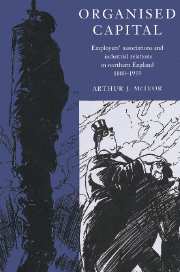Book contents
- Frontmatter
- Contents
- List of maps and tables
- Acknowledgements
- List of abbreviations
- Introduction
- Part 1 Setting the scene
- Part 2 Forging employers' organisations, 1880–1920
- Part 3 Reacting to the economic slump, 1920–39
- 7 The millowners' counter-attack
- 8 Stabilising labour markets: building
- 9 Defending managerial prerogative: engineering
- Conclusion
- Bibliography
- Index
7 - The millowners' counter-attack
Published online by Cambridge University Press: 14 October 2009
- Frontmatter
- Contents
- List of maps and tables
- Acknowledgements
- List of abbreviations
- Introduction
- Part 1 Setting the scene
- Part 2 Forging employers' organisations, 1880–1920
- Part 3 Reacting to the economic slump, 1920–39
- 7 The millowners' counter-attack
- 8 Stabilising labour markets: building
- 9 Defending managerial prerogative: engineering
- Conclusion
- Bibliography
- Index
Summary
Pre-war and wartime co-operation and incorporation strategies proved to be short-lived and with the onset of a deep economic recession from the autumn of 1920 employers moved on to the offensive against trade unions. Evidence suggests that the markedly altered economic circumstances and onset of mass unemployment empowered employers and precipitated a concerted counter-attack, spearheaded by their collective organisations. This was designed primarily to roll back the concessions labour had won over the ‘radical decade’ of 1910–20. The nature of this movement differed markedly between industries, with significant divergences in the strategies promulgated by the worst hit, export-orientated sectors – including cotton and sections of engineering – and those industries – including building – with more sheltered markets. The export sector witnessed a dual offensive, on the one hand to reassert managerial authority on the shop-floor and on the other to reduce labour costs substantially. Utilisation of the range of coercive weapons at the disposal of Employers' associations revived, including the lock-out, whilst employers also benefited from an anti-labour propaganda campaign and the emergence of more centralised and clandestine blacklisting mechanisms, designed to identify labour militants and ensure their removal from the shop-floor. Decontrol and the drawing back from active intervention in industrial relations by the state were also welcomed by most employers' associations. In cotton, engineering and other hardpressed export trades the battle was fought upon the principle of management's right to organise production and employ whom they thought fit under conditions determined unilaterally by the employers. The initial priority was to curtail wartime aspirations of ‘encroaching’ workers' control.
- Type
- Chapter
- Information
- Organised CapitalEmployers' Associations and Industrial Relations in Northern England, 1880–1939, pp. 183 - 210Publisher: Cambridge University PressPrint publication year: 1996



